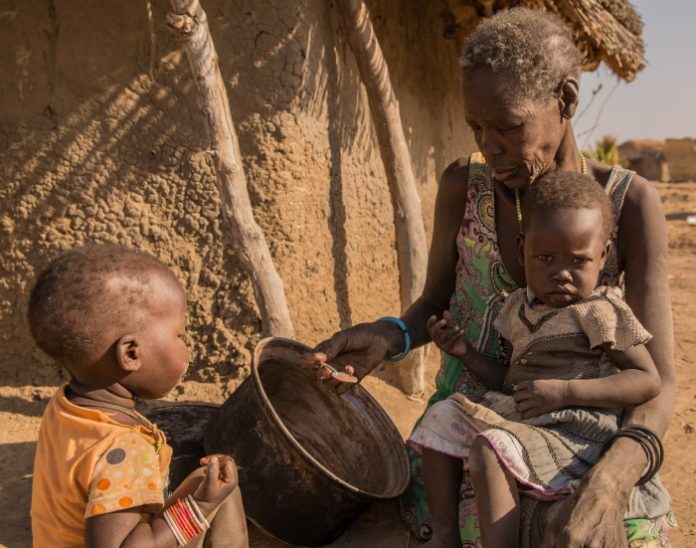By Hellen Toby
JUBA, Dec 3 (Thomson Reuters Foundation) – In Shirkat cattle camp on the outskirts of Juba, farmers say South Sudan’s increasingly unpredictable weather has turned their lives into a series of dilemmas.
Unexpected showers during the cold season can cause cows to contract East Coast Fever, a potentially fatal illness.
Farmers then have to choose between paying for medicine that costs nearly $40 per dose or leaving their cattle untreated and hoping they survive, said camp leader Deng Bul.
When the dry season comes early or lasts longer than usual, pastoralists face another tough decision: Do they stay and wait for rain – possibly losing some animals to starvation – or move to other pastures and risk getting caught up in the country’s ongoing civil war?
If they knew when heavy rain or drought were coming, the farmers said, they could make better decisions about their cattle and crops.
But in South Sudan, where two of the main economic activities – farming and pastoralism – rely heavily on sufficient and regular rainfall, the essential service of weather forecasting has been largely missing since the young nation attained its independence from Sudan in 2011.
Decimated by civil war, South Sudan’s meteorology department is now barely running, with inadequate funding, outdated equipment and untrained staff, experts say.
As a result, it is unable to provide even the most basic weather information to the public, they say, with some people even unaware it exists.
When told there was a meteorological station nearby in Juba dedicated to predicting the weather, the farmers in Shirkat cattle camp said they had no idea the service even existed.
“I’ve never heard of this witch doctor you are talking about. Maybe it is for the educated,” Bul said.
A cow infected with East Coast Fever due to cold weather at Shirkat cattle camp in South Sudan’s capital, Juba. October 27, 2018. Thomson Reuters Foundation/Hellen Toby
MORE DATA, BETTER DECISIONS
Achiku Rashid Wani, a farmer in Juba’s Gudele suburb, said he had heard of South Sudan’s weather service, but said it is useless for most farmers.
He grows vegetables during the dry season using a petrol-powered water pump.
“The factor that is affecting me is the fuel prices; it is expensive,” he told the Thomson Reuters Foundation.
“If I could get information from this (meteorological) department, it would help me plan when to spend money on fuel.”
Before the start of the second Sudanese civil war in 1983, southern Sudan had just over 40 meteorological stations, said Nhial Titmamer, a senior researcher at the Sudd Institute, a Juba-based research organisation.
They generated data made available to the public, making them essential to farmers, Titmamer said.
But most were destroyed in the fighting, with the war playing “a huge role (in) reducing the capacity” of the remaining stations, Titmamer said.
Of the five weather bases still standing, only three are operational, according to Mojwok Ogawi Modo, director-general of the South Sudan Meteorological Department (SSMD).
Since South Sudan gained its independence, the bases have come under management of the new nation’s own meteorological department.
While there are smaller weather stations around the country, set up by various international organisations, and many farmers keep their own records of the local weather, there is no way to collate, analyse or share the data with the public, experts say.
A Campbell-stokes sunshine recorder is one of the few remaining functional weather instruments at the South Sudan Directorate of Meteorology at the International Airport in the capital, Juba. November 3, 2018. Thomson Reuters Foundation/Hellen Toby
OLD AND SPOILED
South Sudan’s largest weather station is run out of one small, crowded room on the second floor of the control tower at the Juba International Airport.
The space is so tight that its employees have trouble moving in and out of the room.
It “is not a favourable working environment,” Modo said.
Most of the computers are old, some are broken, and some sit unused because there are not enough people qualified to operate them, he said.
The department does not have enough devices to accurately observe or forecast the weather, Modo said. “The few we have are old and many are spoiled.”
With no money to buy modern electronic weather-monitoring equipment, the SSMD relies on older methods.
Attached to a metal pole just outside the control tower is a white wooden box with slatted sides, called a Stevenson screen, with wet and dry barometers and a thermometer inside it.
Two rain gauges sit in an overgrown okra garden, but only one of them works, said a member of the met department staff who asked not to be named.
And nearby, there is a Campbell-Stokes sunshine recorder. Based on antique technology, the gadget consists of a solid glass sphere that concentrates the sun’s rays onto a piece of calibrated paper to make scorch marks indicating the time and intensity of the sunshine.
This machine, however, has no paper.
Nearby, the skeletal remains of a radar antenna serve as a reminder that Juba once had a fully functioning weather surveillance system.
With no equipment to detect precipitation, South Sudan’s meteorologists say they can’t perform the basic service of predicting the timing, intensity or location of incoming rainfall.
Using the few resources it does have, the Juba met station provides weather information to aircraft traveling in and out of the capital. But to make that data more widely available, the SSMD needs more funding, Modo said.
The department has a website, but can’t afford to keep it updated.
“If we could get some assistance, the website would be an essential tool” for farmers, he said.
LOOKING TO THE SKIES
According to Modo, the government has plans to build met stations in all of the country’s 32 states. But the proposal is still in the early stages and at the moment there is not enough funding to carry out the “huge task,” he said.
As well as building more met stations, he would like to see the government develop products and services aimed at getting weather data quickly to rural communities, helping people who are most impacted by drought and flooding.
“We could copy countries like Uganda, where mobile phones are distributed to community leaders and farmers so they can get early warning of disaster,” he said.
For now, farmers and herders in South Sudan can only look to the skies for the information they need to cope with the country’s fast-changing climate.
“When it is cloudy, I know it will rain. And I also know the rainy season starts from around May and the dry season begins from around October,” said Mary Kiden, a subsistence farmer in Juba’s Munuki suburb.
“I didn’t know we have meteorological stations that provide us with such information,” she said. (Reporting by Hellen Toby, Editing by Jumana Farouky and Sebastien Malo



















